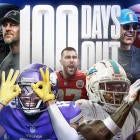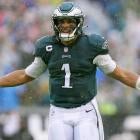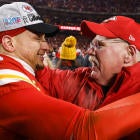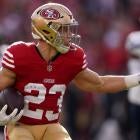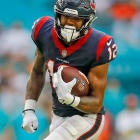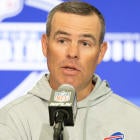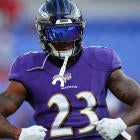In the lead-up to the NFL Draft, everyone wants to know what their favorite team is going to do. Will they pick the stud wide receiver, take a chance on an athletic cornerback, or shoot for a pass rusher? Where do they get that information before the actual draft happens? Mock drafts, of course. Scouts and reporters combine their expertise with information from team sources to attempt to project which players will fall where, and they release those projections out into the world.
It's an inexact science, to be sure, but it's fun and the information can give us a window not only into which teams are considering which players, but where both the NFL media and the scouting community feels a player's stock lies. That's why, during this mock draft season, I set out to track the "mock stock" of 24 different possible first-rounders through the lens of 10 different mock drafters. I explained the methodology a few weeks back when there was a sudden uprising of "the Bucs will draft Marcus Mariota" (which lasted all of a few hours before the rumor dissipated), but I'll do so again here.
Since the week after the Super Bowl, I've followed the mock drafts of the following 10 mock drafters, who for the rest of this article we'll refer to as The Crowd.
- Rob Rang, The Sports XChange/CBS Sports
- Dane Brugler, NFL Draft Scout/CBS Sports
- Pete Prisco, CBS Sports
- Mel Kiper Jr., ESPN
- Todd McShay, ESPN
- Lance Zierlein, NFL.com
- Bucky Brooks, NFL.com
- Daniel Jeremiah, NFL.com
- Matt Miller, Bleacher Report
- Daniel Kadar, SBNation
In addition to the three mock drafts we've been housing during the offseason at CBS, I thought it prudent to include Kiper and McShay, as well as randomly selected mockers from NFL.com's panel. ESPN and NFL Network carry the draft on TV, so it felt right to have voices from those two outlets in The Crowd. After that, I wanted to pick two analysts who only cover the draft, and since Miller and Kadar are well-known to do just that, they made sense.
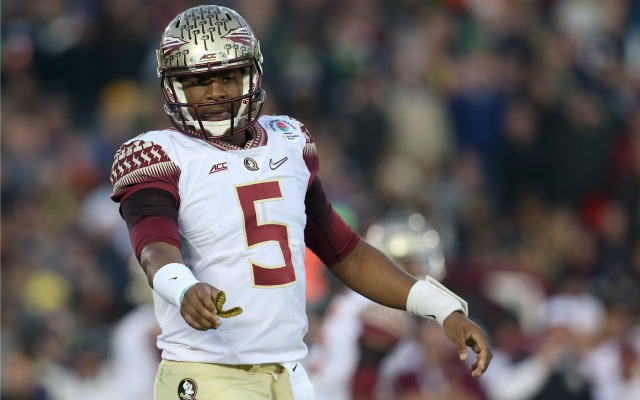
On the following dates, I simply entered in the corresponding selection from each mocker's most recent mock draft for each of the 24 prospects into an Excel spreadsheet to track their stock:
- Feb. 6 (the week after the Super Bowl)
- March 6 (the week after the NFL combine)
- March 20
- April 3
- April 10
- April 17
- April 24
- April 30 (draft day, by 4 p.m. eastern)
Let's look at it quickly through the lens of Georgia running back Todd Gurley, who was selected with the 10th overall pick by the St. Louis Rams.

Here's a key to reading the chart:
- The number in each cell is the selection with which each member of The Crowd had the prospect being selected in their most recent mock draft as of the date in the left-most cell.
- If the prospect was NOT selected in the first round in any given Crowd member's mock draft, they were assigned a value of 33, or the first pick of the second round.
- If the crowd member did not file a new mock draft within the given time period, the corresponding cell was marked with three dashes (---) and not included in the "AVERAGE" for that given week (see below).
- Black cells with green type represent the Crowd member(s) that had the prospect going with the highest selection in that given week. For example, on the morning of the draft, Dane Brugler and Matt Miller had Gurley being selected No. 8, higher than any other Crowd members, so those cells are colored black with green type.
- Black cells with red type represent the Crowd member(s) that had the prospect going with the lowest selection in that given week. For example, on the morning of the draft, Pete Prisco and Todd McShay had Gurley being selected No. 17, lower than any other Crowd members, so those cells are colored black with red type.
- The column labeled "AVERAGE" is the average of each prospect's selections in that given week.
- The "AVERAGE" column is also color-coded. Black type represents the prospect's initial average the week after the Super Bowl. In the subsequent weeks, green type represents a rise in average from the previous week; red type represents a drop in average from the previous week; and blue type represents an identical average to the previous week.
Of the 24 prospects I initially chose to track, 20 were chosen in the first round, including each of the first 15 picks and 17 of the first 18 (the lone untracked top-18 pick was Wake Forest cornerback Kevin Johnson). Let's work through those prospects in the order they were drafted to see how accurately their stock was reflected by The Crowd, and provides some additional notes along the way.

Who nailed it: Everyone
Notes: As you can see, after the combine, Winston's average selection did not fluctuate one bit. He went No. 1 in 60 of the 61 mock drafts filed by The Crowd during this time period. The lone holdout was Kadar's initial mock, which had Marcus Mariota going first.

Who nailed it: Everyone
Notes: The Crowd took a more circuitious route to coming around on Mariota going No. 2 overall. He was most commonly mocked at No. 6 to the New York Jets, being selected there in 24 of 61 mocks compared to 23 of 61 at No. 2. He was selected as low as first and as high as 18th. From February 6 through April 10, his average selection barely budged, hovering in a range of 5.9 to 6.5. But it rose in each of the last five weeks tracked, as it became more and more clear that either the Titans or some other team would take him with the second overall pick.

Who nailed it: Dane Brugler, Matt Miller
Who was way off: Dan Kadar had Fowler dropping to the Falcons at No. 8, the farthest away from where he was actually selected.
Most common landing spot: No. 3, Jaguars (32 of 61 mocks)
Notes: Every member of The Crowd that filed a mock that week actually had Fowler going No. 3 to Jacksonville back on March 20, but then they all started moving him around. Nobody had him No. 3 wire-to-wire. The closest was Daniel Jeremiah, who had Fowler No. 3 in each of his first five mocks before moving him down to No. 5 on draft day. Fowler's average selection jumped 3.5 spots from the initial projections after the Super Bowl until draft day (8.3 to 4.8), but it still wasn't high enough compared to where he actually went.

Who nailed it: Rob Rang, Mel Kiper
Who was way off: Dane Brugler had Cooper dropping to the Rams at No. 10, the farthest away from where he was actually selected.
Most common landing spot: No. 4, Raiders (27 of 61 mocks)
Notes: With the exception of the week after the combine, Rang had this pick wire-to-wire. Cooper's mock stock took a momentary post-combine dip after Kevin White put on a show, but in every other week tracked, he was the first receiver off the board, on average. He was selected as high as No. 3 in some mocks and never lower than No. 18, and his average selection fluctuated between 5.1 (draft day) and 8.2 (the week after the combine). His average rose in five of the seven time periods tracked after the initial post-Super Bowl mock.

Who nailed it: Nobody
Who was way off: Pete Prisco had Scherff dropping to the Chiefs at No. 18, the farthest away from where he was actually selected.
Most common landing spot: No. 9, Giants (23 of 61 mocks)
Notes: Rob Rang actually had Scherff going to Washington in each of his first six mocks, but switched course and dropped him to the Jets at No. 6 in each of the last two weeks. Scherff had a very wide range of individual selections -- he went as high as No. 5 and as low as No. 25, but his overall average had a very tight range of 8.4 to 10.3. There was very rarely a consensus on him in any given week -- only twice did more than one Crowd member have him in the same slot.

Who nailed it: Nobody
Who was way off: Rob Rang, Pete Prisco and Mel Kiper had Williams coming off the board at No. 3, the farthest away from where he was actually selected.
Most common landing spot: No. 2, Titans (34 of 61 mocks)
Notes: Williams was not mocked to the Jets in any of the 61 mock drafts filed by The Crowd, though he fell out of the top five picks in only two of the 61 mocks, so he was rarely available to be picked in that slot. A near-consensus emerged the week after the combine, as all but one Crowd member had him going No. 2 to Tennessee that week. His mock stock had an average range of 2.1 to 3.6, where it resided for the last two weeks. Though there was a general agreement Williams would be a top 2-4 pick, only Brooks had Williams going the exact same slot in each iteration of his mock draft.

Who nailed it: Rob Rang, Dane Brugler, Todd McShay, Daniel Jeremiah, Dan Kadar
Who was way off: Matt Miller had White dropping to the Giants at No. 9, the farthest away from where he was actually selected.
Most common landing spot: No. 7, Bears (18 of 61 mocks)
Notes: White's mock stock seems like it was all over the place because his average selection never went up or down in consecutive weeks, but after the combine, he actually had a very tight range of 6.7 yo 8.0, and his draft day average was exactly 7.0, which is where he was actually selected. White momentarily moved ahead of Amari Cooper in terms of average selection the week after the NFL combine, but he was otherwise hte second receiver off the board, on average, in every time period. He only went top-10 in two of the initial post-Super Bowl mocks, but after the combine, he only fell out of the top-10 in two of the 51 mocks filed. Brugler had White going to the Bears at No. 7 in his five most recent mocks, white Jeremiah and Kadar never had him there once until draft day.

Who nailed it: Nobody
Who was way off: Rob Rang, Mel Kiper and Daniel Jeremiah had Beasley dropping to the Saints at No. 13, the farthest away from where he was actually selected.
Most common landing spot: No. 5, Washington (18 of 61 mocks)
Notes: Beasley actually did go to the Falcons in 16 mocks, but everyone who once had him there, eventually moved him out of the slot. Brugler and Prisco did so twice. Beasley had a huge range of individual selections, going as high as No. 3 and as low as out of the first round entirely. His mock stock shot up 9.0 spots from the initial post-Super Bowl projections to draft day, and his average of 8.1 actually represented where he got picked, even if nobody had him going No. 8. Washington, Atlanta and New Orleans were the landing spots most seemed to have in mind for Beasley throughout the process; he went one of those three spots in 47 of 61 mocks.

Who nailed it: Mel Kiper
Who was way off: Dan Kadar had Flowers dropping to the Colts at No. 29, the farthest away from where he was actually selected.
Most common landing spot: Out of first round (15 of 61 mocks)
Notes: The Crowd was WAY off on Flowers, at least in terms of projecting where he'd be drafted. His average selection never rose higher than No. 20, and he wound up going in the top-10 picks, where he fell in only five of 61 mocks. Kiper's draft day mock was the only one that had the Giants picking Flowers. Other than going unselected, his most common landing spots were 21 (Bengals), 23 (Lions) and 25 (Cardinals).

Who nailed it: Nobody
Who was way off: Pete Prisco and Todd McShay had Gurley dropping to the Chargers at No. 17, the farthest away from where he was actually selected.
Most common landing spot: No. 17, Chargers (15 of 61 mocks)
Notes: The Crowd was also pretty far off on Gurley, though they got closer and closer as the weeks went by. His average mock stock started down at 28.1, dipped to 28.8 after he didn't run at the combine, but steadily rose all the way to 13.1 after that. He wasn't mocked to the Rams once in any of the 61 mocks filed by The Crowd, though he did make it into the top-10 three times, going as high as No. 6. Still, as recently as 20 days before the draft, there were still people mocking Gurley outsidre the first round, and he wound up going No. 10 overall.

Who nailed it: Rob Rang, Dane Brugler, Pete Prisco, Mel Kiper, Todd McShay, Daniel Jeremiah
Who was way off: Dan Kadar wad Waynes dropping to the Steelers at No. 22, the farthest away from where he was actually selected.
Most common landing spot: No. 11, Vikings (23 of 61 mocks)
Notes: There was a pretty large draft day consensus that Waynes would go No. 11, and that's what happened. In early mocks he occasionally went behind Marcus Peters (he was out of the first round in one), but otherwise Waynes was consistently the top corner off the board, rising as high as No. 9.

Who nailed it: Dane Brugler, Pete Prisco, Mel Kiper, Todd McShay, Dan Kadar
Who was way off: Rob Rang, Daniel Jeremiah and Matt Miller had Shelton dropping to the... Browns at No. 19, the farthest away from where he was actually selected.
Most common landing spot: No. 12, Browns (20 of 61 mocks)
Notes: Every Crowd member had Shelton to the Browns by draft day, only three of them had Shelton lasting until No. 19. He went to Cleveland in 29 of 61 mocks, but Chicago at No. 7 was a popular landing spot early on in the process. Shelton's average stayed between 10.0 and 12.6 until draft day, when the three Crowd members who mocked thim to Cleveland at 19 dropped the average to 14.6.

Who nailed it: Todd McShay
Who was way off: Dane Brugler had Peat dropping to the Lions at No. 23, the farthest away from where he was actually selected.
Most common landing spot: No. 21, Bengals (13 of 61 mocks)
Notes: The only time Peat landed at No. 13 was in McShay's draft day mock. His stock was all over the board, as high as No. 6 and as low as out of the first round altogether. The Crowd did give Peat a big jump between last week and draft day, moving his mock stock from 20.9 all the way to 14.3, a better reflection of where he was actually picked.

Who nailed it: Dane Brugler, Pete Prisco, Todd McShay, Daniel Jeremiah
Who was way off: Mel Kiper had Parker going off the board to the Rams at No. 10, the farthest away from where he was actually selected.
Most common landing spot: No. 11, Vikings (15 of 61 mocks)
Notes: The Crowd had Parker's stock pegged pretty nicely. His average vacillated between 11.8 and 13.1, and he actually went 14th overall. He was the third receiver off the board in nearly every mock draft, and he was the third receiver off the board on draft day.

Who nailed it: Nobody
Who was way off: Daniel Jeremiah had Gordon dropping to the Ravens at No. 26, the farthest away from where he was actually selected.
Most common landing spot: No. 17, Chargers (16 of 61 mocks)
Notes: Well, maybe we shouldn't say "nobody" had the pick right. Gordon's most commong landing spot was the Chargers, and five draft day mocks had him going to San Diego. They just traded up two spots to get him. Like Todd Gurley's, Gordon's stock rose pretty consistently over the last few weeks as it became increasingly clear he'd be a first-round pick. A lot of mocks had him falling to No. 24 and the Cardinals, but that wasn't in the... cards. Nailed it.

Who nailed it: Nobody
Who was way off: Rob Rang had Armstead dropping to the Saints at No. 31, the farthest away from where he was actually selected.
Most common landing spot: No. 15, 49ers (23 of 61 mocks)
Notes: Much like with Gordon, a lot of mocks had Armstead targeted to the 49ers, and three had that fit on draft day. He went as high as No. 8 and as low as out of the first round, but his average range was only 15.0 to 23.7. His average was exactly 15.0 to the 49ers last week as five of the seven filed had that match picked out, but he got moved around the board in the draft day mocks, which caused his average to drop all the way to 20.1.

Who nailed it: Nobody
Who was way off: Rob Rang had Peters dropping to the Cowboys at No. 27, the farthest away from where he was actually selected.
Most common landing spot: No. 15, 49ers (14 of 61 mocks)
Notes: Peters wasn't mocked to the Chiefs once in any of the 61 mocks filed by The Crowd. Miller was consistently the highest on Peters, getting a black/green box in five of his six filed mocks in the period. Peters' mock stock pretty much never stayed consistent, vacillated up and down from week-to-week. Eventually, The Crowd was pretty close. His draft day average of 21.0 was within three slots of his actual selection.

Who nailed it: Nobody
Who was way off: Mel Kiper, Todd McShay and Matt Miller all head Ray dropping out of the first round altogether.
Most common landing spot: No. 8, Falcons (12 of 61 mocks)
Notes: There was almost no consensus on Ray, but part of that is due to his arrest for marijuana possession in the days before the draft, which caused his stock (both in mock drafts and the real one) to tumble even farther than it already was. He'd dropped in four straight periods until moving up the week before the draft, but the arrest sunk his mock stock average from 11.5 all the way to 27.0. The Broncos wound up trading up to No. 23, and giving up a pretty significant haul to get him, so it's clear at least one team valued him petty highly.

Who nailed it: Nobody
Who was way off: Everybody except Dane Brugler had Thompson dropping out of the first round.
Most common landing spot: Not selected (49 of 61 mocks)
Notes: Thompson was the surprise selection of the first round, and that was reflected in his mock stock. He was out of the first round entirely for four straight weeks until Brugler put him at No. 27 to the Cowboys on draft day. He wasn't mocked to the Panthers once in the 61 mocks filed by The Crowd, unsurprising since they have so many needs elsewhere.

Who nailed it: Nobody
Who was way off: Matt Miller had Brown coming off the board to the Bengals at No. 21, the farthest away from where he was actually selected.
Most common landing spot: No. 23, Lions (15 of 61 mocks)
Notes: Brown was consistently mocked in the late teens and early 20s. Hia average ranged from 18.2 to 24.9, and he was only mocked to the Patriots once, by Brugler on April 17. Prisco was seemingly lowest on Brown, as he got a black/red box in four of his filed mock drafts. There was nobody who had him in the same spot wire-to-wire.
The four selected prospects who fell out of the first round were Randy Gregory, T.J. Clemmings, Dorial Green-Beckham and Jaelen Strong. Below, you'll find a chart that shows each of the 24 prospects' initial average mock selection the week after the Super Bowl, their draft day average mock selection, the change in their mock stock from the initial average to draft day, their actual pick (again, with 33 representing a fall out of the first round), and the difference between their initial average and actual pick, as well as their draft day average and actual pick.
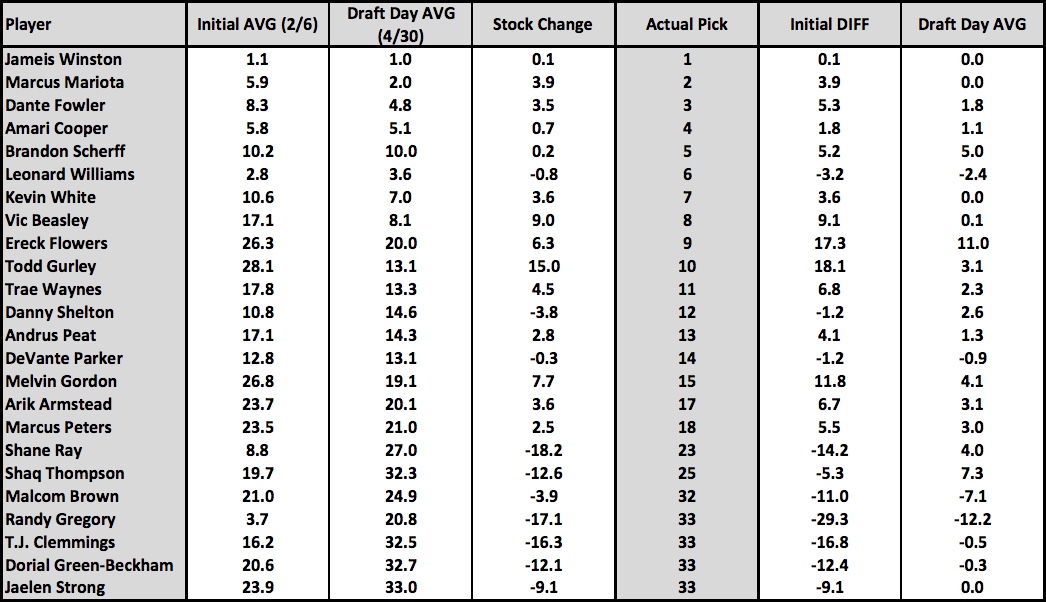
As you can see, there was a lot of movement around the board for a lot of these prospects. Most notable is Gregory, whose post-Super Bowl average selection of 3.7 dropped all the way to 20.8 by the time the draft day mocks rolled out, and of course he actually fell out of the first round altogether. Clemmings and Green-Beckham also had large drops, while Gurley took a massive leap. In all, The Crowd did a about as good a job of predicting picks as any individual mocker, coming within three spots of nailing 14 of the 20 prospects I tracked, getting three exactly right and another within 0.1 picks.













